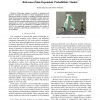Free Online Productivity Tools
i2Speak
i2Symbol
i2OCR
iTex2Img
iWeb2Print
iWeb2Shot
i2Type
iPdf2Split
iPdf2Merge
i2Bopomofo
i2Arabic
i2Style
i2Image
i2PDF
iLatex2Rtf
Sci2ools
83
Voted
IROS
2008
IEEE
2008
IEEE
Motion recognition and generation by combining reference-point-dependent probabilistic models
— This paper presents a method to recognize and generate sequential motions for object manipulation such as placing one object on another or rotating it. Motions are learned using reference-point-dependent probabilistic models, which are then transformed to the same coordinate system and combined for motion recognition/generation. We conducted physical experiments in which a user demonstrated the manipulation of puppets and toys, and obtained a recognition accuracy of 63% for the sequential motions. Furthermore, the results of motion generation experiments performed with a robot arm are presented.
IROS 2008 | Object Manipulation | Reference-point-dependent Probabilistic Models | Robotics | Sequential Motions |
Related Content
| Added | 31 May 2010 |
| Updated | 31 May 2010 |
| Type | Conference |
| Year | 2008 |
| Where | IROS |
| Authors | Komei Sugiura, Naoto Iwahashi |
Comments (0)

